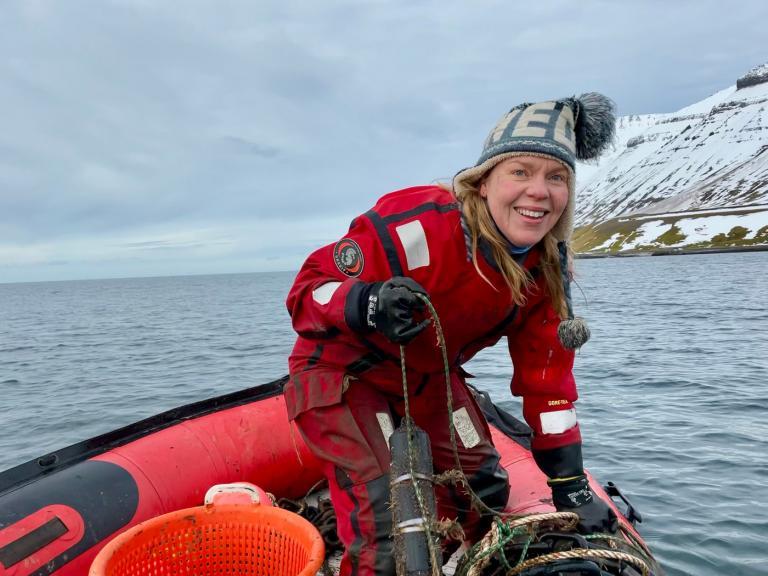
A groundbreaking new study by UI scientists has shed new light on the impact of 1100 years of fishing on the cod population around Iceland. The study reveals that cod in the 10th, 11th and 12th centuries were on average 25% larger and up to three times older than cod living today. However, cod during the settlement of Iceland grew at a much slower rate than now, since the size of the population had a significant impact on access to food. Increased fishing in the 14th century had an immediate effect on the size of the cod stocks – there is significant evidence suggesting that European fishing in Icelandic waters was much more extensive than previously thought. These findings were recently published in the prestigious journal Science Advances.
The team behind the study is multidisciplinary, but the principal investigator is Steven Campana, professor of marine biology at UI. The other researchers in Iceland include Guðbjörg Ásta Ólafsdóttir, biologist and director of the UI Research Centre in Bolungarvík, Ragnar Edvardsson, archaeologist at the same centre, and Árni Daníel Júlíusson, historian at the Vigdís Finnbogadóttir Institute and the Stefansson Arctic Institute, and Einar Hjörleifsson from the Marine and Freshwater Research Institute
Fishing began earlier than previously thought
The team’s findings provide a unique insight into the natural cod stocks before fishing began and also how increased fishing had an immediate impact in the 14th century. Slower growth, for example, is evidence of a density-dependent impact – that is, because the population was so large in this period, competition for food was more intense.
“It was rather surprising to see that changes to the cod stocks began to occur as early as the 14th and 15th centuries, at which point fishing had increased to meet the demand for stockfish on the European markets. We can see that cod mortality rose,” explains Guðbjörg Ásta Ólafsdóttir, biologist at UI.
“We can calculate mortality from the age distribution of the population, since in a natural stock without fishing pressures, there are far more older individuals. This is an extremely important finding, both for understanding the scope of historical fishing but also because knowing the natural mortality of cod is vital for assessing the population today. Until now, it has been impossible to verify cod mortality before fishing began.”
Otoliths are like memory chips recording a cod’s life
This population ecology study, covering a period from the settlement of Iceland to the modern day, used otoliths (‘earstones’) from cod heads excavated at historical fishing stations. The findings reveal that cod around Iceland in the 10th century were much larger and older than they are today, which reflects limited fishing pressures during the first hundred years after the settlement as well as the immediate impact of fishing in the 14th and 15th centuries.
Guðbjörg Ásta explains that Steven Campana, professor of marine biology, joined the team with extensive experience of using otoliths in ichthyological research and it was this approach that really increased the scientific value of the project for modern ichthyology.
A large number of otoliths were discovered through archaeological excavation of old fishing stations. These stations were established at the time of the settlement and in some cases remained in use well into the 20th century. Information gleaned from the otoliths has revolutionised what we know about cod population ecology in Icelandic waters going back as far as the settlement.
Steven explains: “Otoliths are really like a kind of memory chip which we can read to get a record of the cod’s life. Cod and all other bony fish have otoliths, which are calcium carbonate structures in the saccule of the inner ear. Otoliths are used a lot in modern ichthyological research and are key to evaluating fish stocks.”
Guðbjörg Ásta agrees, adding that otoliths grow at the same rate as the fish themselves: fast in the summer and slowly in the winter. Otoliths therefore form noticeable annual growth rings, which can be used to determine the age of the fish and its growth rate each year.
Study originated in archaeological research on fishing stations in the West Fjords
The story behind this study is long and fascinating. It all began with the doctoral research of the archaeologist Ragnar Edvardsson, looking at ancient Icelandic fishing stations, e.g. in Skálavík and Breiðuvík. Ragnar’s research sparked interest not only in historical cod fishing but also the hugely valuable organic materials discovered at these old fishing stations.
“It was clear from my research that the development of Icelandic society was closely linked to changes in the cod population, at least from the later half of the 12th century,” says Ragnar.
“So we needed to research the population ecology of the cod from the start of the settlement in order to evaluate how changes to the cod stocks affected Icelandic society. We also needed to try to get an idea of the extent of foreign fishing in Icelandic waters through history, since its impact on Icelandic society and the cod population has long been underestimated.”



